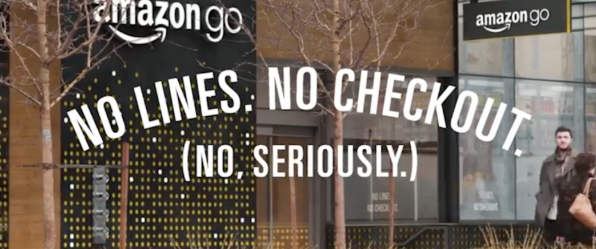Amazon’s store of the future, Amazon Go, has become reality in 2016 and has been a leading example for the use of in-store technologies ever since (Amazon, 2018). The notorious checkout-free convenience store opened its doors for an employee-only focus group after years of development (Rey, 2017). It took the e-commerce giant an additional year to tweak its technology, which appeared to run into difficulties when items were being misplaced, when it had to track over 20 shoppers simultaneously, or when their movement was too fast (Dastin 2018; Mogg, 2017). Amazon’s reported goals? By increasing the level of convenience in its convenience store, Amazon may be able to increase its online base of customers offline, which is where the majority of retail sales are still made (Thomas, 2017). Moreover, increasing data collection would allow Amazon to learn even more about the shopping habits of its customers (Karsten & West, 2018).
Within the Amazon Go store, Amazon’s “Just Walk Out Technology” enables shoppers to go about their regular groceries without waiting in line for the checkout. Instead, shoppers simply walk out and are billed through their Amazon account. All shoppers need is an Amazon account and the Amazon Go app, with which to enter the store.
To realize checkout-free shopping, the Amazon Go store is filled with cameras and sensors to allow the use of computer vision and sensor fusion. To illustrate, image analysis may be able to cut down the list of likely matching items, whereas combined with weight sensors, the single item in question may be identified. To continuously train the accuracy of its results, and hence the accuracy of its virtual shopping carts, Amazon is using deep learning technology (Deoras, 2018).
Amazon’s tech grocery store has not remained unnoticed for incumbents in the grocery retailing industry. For example, the largest Dutch grocery chain, Albert Heijn, has recently introduced checkout-free shopping at two of its AH To go stores. Using the “Tap to go” technology, shoppers simply tap against the price tag of their selected product(s) and are billed ten minutes after their final tap (Andersen, 2018).
Even though checkout-free shopping is not mainstream yet, I do see much potential for it to become so. If Amazon’s planned expansion to 3.000 stores by 2021 becomes reality, Amazon Go would become one of the largest chains in the United States (Soper, 2018). The aforementioned may lead to a snowball effect of retailers implementing checkout-free shopping technologies in an attempt to compete with the e-commerce giant. Such will have many implications, the most obvious one concerning the eliminated need for cashier jobs.
Opinions differ about when checkout-free shopping will become a widespread reality. Although I do believe that it will be a gradual process, I would not be surprised by a proliferation once shoppers’ patience for waiting lines ceases as they get used to the heightened level of convenience.
Sources:
- https://www.amazon.com/b?ie=UTF8&node=16008589011
- https://www.volkskrant.nl/nieuws-achtergrond/bij-albert-heijn-kun-je-met-de-tap-to-go-pas-in-een-halve-minuut-je-boodschappen-doen~b82f09ff/
- https://www.analyticsindiamag.com/understanding-ai-behind-amazon-go/
- https://www.brookings.edu/blog/techtank/2018/02/13/amazon-go-store-offers-quicker-checkout-for-greater-data-collection/
- https://www.recode.net/2017/3/27/15072084/amazons-go-future-store-delayed-opening
- http://www.scanpaygo.be/index.html
- https://www.bloomberg.com/news/articles/2018-09-19/amazon-is-said-to-plan-up-to-3-000-cashierless-stores-by-2021
- https://www.cnbc.com/2017/08/03/retails-not-dead-and-physical-stores-still-matter-goldman-says.html

